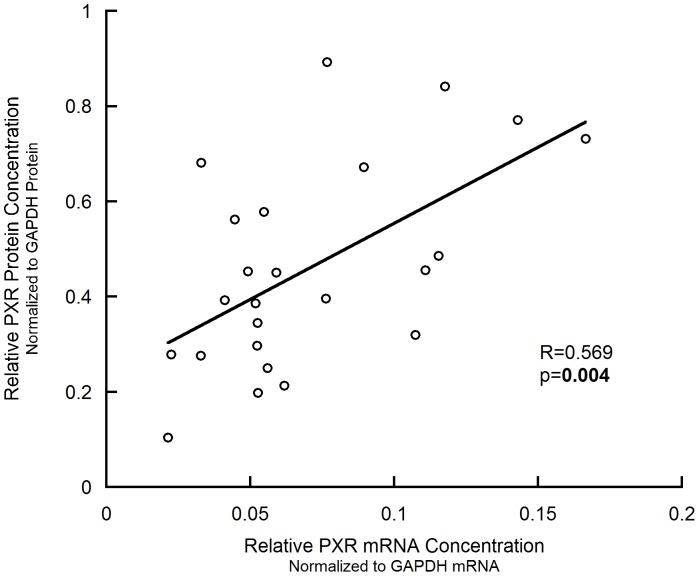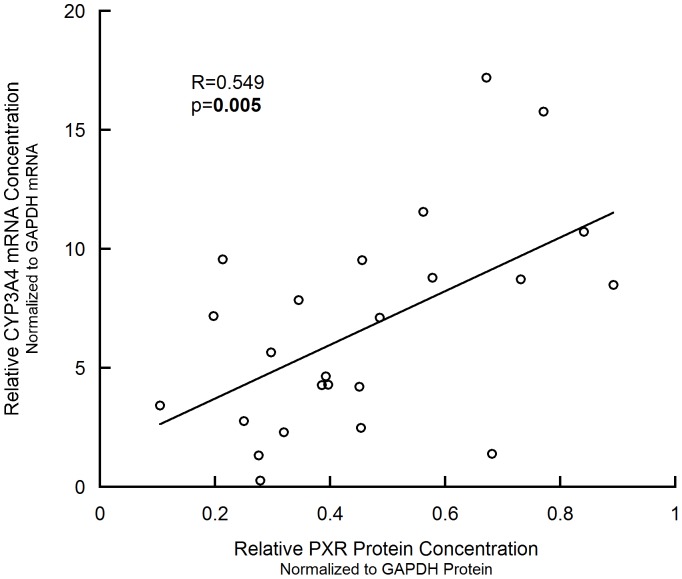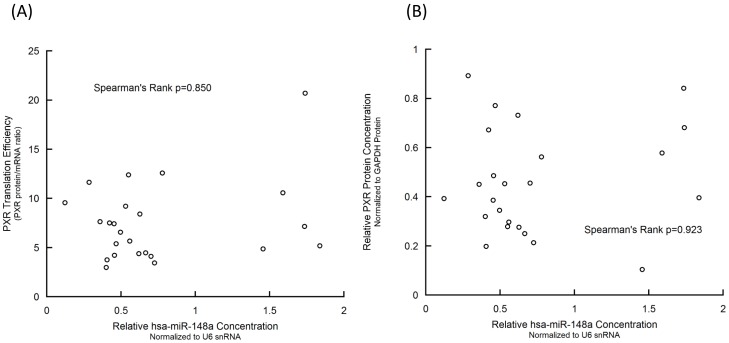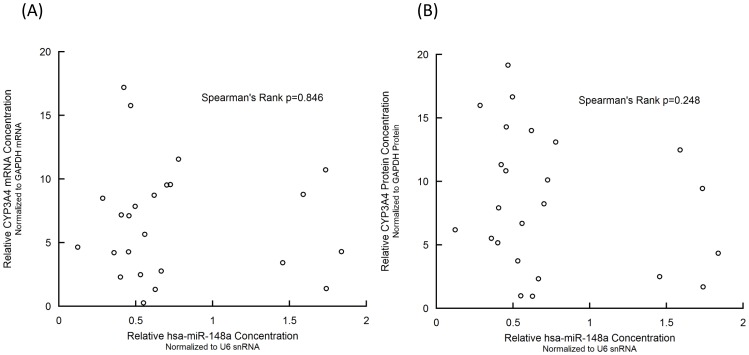Abstract
There is a huge variability of hepatic CYP3A4 level in human populations, which was believed to contribute to different responses to drugs among individuals. Transcription of CYP3A4 was regulated by transcription factors such as pregnane X receptor (PXR). MiRNA hsa-miR-148a was previously reported to influence PXR expression in HepG2 cells and in Japanese populations. In this study, we conducted a similar correlation study in Chinese Han population (N = 24). No significant correlation of hsa-miR-148a was found with PXR expression or CYP3A4 expression. Our results suggest that hsa-miR-148a does not play a major role in the regulation of PXR or CYP3A4 expression in human livers from Chinese Han population.
Introduction
Cytochrome P450 3A4 (CYP3A4), the most abundant hepatic and intestinal member of cytochrome P450 superfamily [1], contributes to the metabolism of over half of the current prescription drugs [2], [3]. However, the CYP3A4 level has been reported to vary a lot (as great as 50-fold) in the general population, which cannot be explained by genetic polymorphisms alone [4]. Such huge inter-individual differences of CYP3A4 levels could explain the striking individual differences in drug responses, in terms of both therapeutic effects and adverse side effects [5]. Therefore, the regulation mechanism of CYP3A4 expression became a research hotspot in pharmacokinetics [6], [7].
Previously, Takagi et al. reported that the protein level of pregnane X receptor (PXR), which is a major transcription factor of CYP3A4 [6], [8], [9], correlated significantly with the CYP3A4 mRNA and protein levels in Japanese population [10]. After in vitro investigation with reporter system, they further found that the translational efficiency of PXR (PXR protein/PXR mRNA ratio) was inversely correlated with the expression level of hsa-miR-148a in human livers [10]. Their results suggested the indirect regulatory function of hsa-miR-148a in CYP3A4 expression.
However, there are always controversial conclusions in clinical investigations, especially in different populations. Therefore, we asked whether their results could be replicated in Chinese Han population and whether the effect of hsa-miR-148a on PXR translation could indirectly influence CYP3A4 expression in the population. In the present study, we found that hsa-miR-148a might not play a major role in the regulation of PXR or CYP3A4 expression in human livers from Chinese Han population.
Methods
Liver Samples and Ethics Statement
Human liver samples from 24 Chinese Han donors were obtained in surgery from the First Affiliated Hospital of Zhengzhou University after informed consent was written. The donors included 16 males and 8 females with the age of 40.55±4.63 (mean±SEM). Among them, six had mild cirrhosis and none had Hepatitis B or C. All donors included in this study had normal liver functions and didn’t receive any preoperative medication of CYP3A4 activator or inhibitor (rifampicin, dexamethasone, propofol, etc) for 2 weeks, nor alcohol, grapefruit juice or caffeine-containing foods/beverages within 3 days before the surgery to avoid any inhibitory or inducing effects on CYP3A4 activity. The protocol complied with the Declaration of Helsinki and its subsequent revisions and was approved by the Ethics Committees of Zhengzhou University.
Immunoblot
Total proteins were extracted using RIPA lysis buffers containing protease inhibitor PMSF. Relative protein concentrations of PXR and CYP3A4 were accessed by immunoblot using rabbit anti-PXR antibody (AP8674c; Abgent, CA) and rabbit anti-CYP3A4 antibody (ab3572; Abcam, MA), respectively, normalized to GAPDH protein concentration.
qPCR for mRNA and miRNA
Total RNAs were extracted using TRIzol method (Life technologies, CA), followed by gel electrophoresis for quality control. Total RNAs were reversed to cDNAs using PrimeScript RT Reagent kit (Takara Bio, Dalian, China). The relative concentrations of PXR and CYP3A4 mRNA were measured by qPCR with primers (PXR: 5′-GCCCATGCTGAAATTCCACTA-3′ and 5′-GCCGATTGCATTCAATGTAGGA-3′; CYP3A4∶5′-CCAAGCTATGCTCTTCACCG-3′ and 5′-TCAGGCTCCACTTACGGTGC-3′) using FastStart Universal SYBR Green Master (Roche, IN). GAPDH mRNA was quantified as the endogenous control with primers (5′-ATCACCATCTTCCAGGAGCGA-3′ and 5′-GCTTCACCACCTTCTTGATGT-3′). For miRNA quantification, reverse PCR and qPCR were performed using miRCURY LNA™ Universal RT microRNA PCR system (Exiqon, Denmark). U6 snRNA was measured as the endogenous control. All qPCRs were run on ViiA 7 instrument (Life technologies, CA) with three replicates.
Statistics
Linear regression, Student’s t-test and Spearman’s rank correlation were performed using SPSS for Windows, version 11.0 (IBM, NY). All tests were two-tailed and statistical significance was assumed at p<0.05.
Results
PXR mRNA Level is Correlated with PXR Protein Level in Human Livers
We first examined the PXR mRNA level and protein level in our human liver samples (N = 24) by qPCR and immunoblot, respectively, and investigated the relationship between them. All qPCR and immunoblot data were shown in Table 1. As shown in Figure 1, significant linear correlation was observed between the PXR mRNA and protein levels (p = 0.004, R2 = 0.324).
Table 1. The relative expression of PXR, CYP3A4 and hsa-miR-148a in human liver samples.
| Sample No. | PXR mRNA | PXR protein | CYP3A4 mRNA | CYP3A4 protein | miR-148a |
| 1 | 0.021 | 0.104 | 3.426 | 2.505 | 1.456 |
| 2 | 0.090 | 0.672 | 17.202 | 11.329 | 0.423 |
| 3 | 0.049 | 0.454 | 2.492 | 3.750 | 0.530 |
| 4 | 0.107 | 0.319 | 2.304 | 5.177 | 0.401 |
| 5 | 0.059 | 0.451 | 4.212 | 5.516 | 0.359 |
| 6 | 0.115 | 0.486 | 7.123 | 14.306 | 0.455 |
| 7 | 0.052 | 0.386 | 4.274 | 10.836 | 0.453 |
| 8 | 0.023 | 0.279 | 0.266 | 1.000 | 0.550 |
| 9 | 0.077 | 0.893 | 8.498 | 16.002 | 0.285 |
| 10 | 0.053 | 0.198 | 7.177 | 7.928 | 0.406 |
| 11 | 0.056 | 0.250 | 2.764 | 2.329 | 0.665 |
| 12 | 0.053 | 0.345 | 7.856 | 16.663 | 0.497 |
| 13 | 0.143 | 0.771 | 15.766 | 19.160 | 0.467 |
| 14 | 0.041 | 0.393 | 4.652 | 6.198 | 0.123 |
| 15 | 0.111 | 0.456 | 9.540 | 8.236 | 0.701 |
| 16 | 0.033 | 0.276 | 1.335 | 0.958 | 0.627 |
| 17 | 0.167 | 0.732 | 8.721 | 14.018 | 0.620 |
| 18 | 0.052 | 0.297 | 5.657 | 6.700 | 0.559 |
| 19 | 0.062 | 0.214 | 9.563 | 10.117 | 0.726 |
| 20 | 0.076 | 0.396 | 4.290 | 4.353 | 1.838 |
| 21 | 0.118 | 0.841 | 10.731 | 9.453 | 1.735 |
| 22 | 0.055 | 0.578 | 8.798 | 12.492 | 1.590 |
| 23 | 0.045 | 0.562 | 11.558 | 13.107 | 0.778 |
| 24 | 0.033 | 0.681 | 1.402 | 1.706 | 1.738 |
The relative RNA levels of mRNAs and miRNA were measured using qPCR with the normalization to the GAPDH mRNA level and the U6 snRNA level, respectively. The relative protein levels were measured using immunoblot with the normalization to the GAPDH protein level.
Figure 1. Linear correlation between PXR mRNA and protein levels in human liver samples.
PXR Protein Level is Correlated with CYP3A4 mRNA Level in Human Livers
The CYP3A4 mRNA level in human liver samples was measured by qPCR, and was investigated about its relationship with the PXR protein level. As shown in Figure 2, significant linear correlation was observed between the PXR protein level and CYP3A4 mRNA level (p = 0.005, R2 = 0.301).
Figure 2. Linear correlation between PXR protein and CYP3A4 mRNA levels in liver samples.
Hsa-miR-148a did not Affect Expression of PXR in Chinese Han Population
We calculated the PXR protein/PXR mRNA ratio as an index of the translational efficiency of PXR, according to Takagi et al. [10]. There was no significant correlation between the translational efficiency of PXR and the hsa-miR-148a level in liver samples using Spearman’s rank method (p = 0.850) or linear regression (p = 0.217), as shown in Figure 3A. The hsa-miR-148a level was not significantly correlated with PXR protein level either (Spearman’s rank p = 0.923; Figure 3B).
Figure 3. Hsa-miR-148a was not correlated with the translational efficiency (A) or protein level (B) of PXR.
Hsa-miR-148a did not Show Influence on the Expression of CYP3A4 in Chinese Han Population
To investigate whether hsa-miR-148a could indirectly regulate CYP3A4 transcription, we examined the relationship between hsa-miR-148a level and CYP3A4 mRNA level. As shown in Figure 4, hsa-miR-148a level in human livers was not significantly in Spearman’s rank correlation with CYP3A4 mRNA level (p = 0.848) or protein level (p = 0.248).
Figure 4. No correlation between hsa-miR-148a level and CYP3A4 mRNA (A) or protein (B) levels in livers.
Hsa-miR-148a Grouping or Cirrhosis Grouping didn’t Associate with the Expression of PXR or CYP3A4
The relative expression of hsa-miR-148a seems to aggregate into two groups with a split point as 1.0 as shown in Figure 3. We compared the relative expression of PXR and CYP3A4 between high and low hsa-miR-148a expression groups. As shown in Table 2, there was no significant difference between these two groups. We also analyzed and found that mild cirrhosis status had no significant influence on PXR or CYP3A4 levels (Table 2). To be noticed, mild cirrhosis status didn’t show significant correlation with hsa-miR-148a expression (p = 0.472).
Table 2. The expression of PXR, CYP3A4 and hsa-miR-148a in groups according to hsa-miR-148a level and cirrhosis status.
| Hsa-miR-148a level | Mild cirrhosis | |||||
| High | Low | p-value | Yes | No | p-value | |
| N | 5 | 19 | 6 | 18 | ||
| PXR mRNA level | 0.061±0.017 | 0.073±0.009 | 0.533 | 0.071±0.014 | 0.070±0.010 | 0.946 |
| PXR protein level | 0.520±0.127 | 0.444±0.046 | 0.492 | 0.428±0.107 | 0.470±0.048 | 0.687 |
| PXR translational efficiency | 9.70±2.931 | 6.91±0.704 | 0.174 | 6.301±1.268 | 7.892±1.010 | 0.413 |
| CYP3A4 mRNA level | 5.729±1.740 | 6.893±1.055 | 0.611 | 5.973±1.234 | 6.876±1.139 | 0.673 |
| CYP3A4 protein level | 6.102±2.090 | 9.123±1.249 | 0.270 | 9.017±2.431 | 8.319±1.249 | 0.789 |
| hsa-miR-148a level | 1.672±0.067 | 0.507±0.037 | 9.3E-13 | 0.616±0.178 | 0.794±0.126 | 0.472 |
Data expressed as mean±SEM. Homoscedasticity between groups was verified using Levene’s test.
Discussion
PXR is a major transcription factor of CYP3A4 gene, and regulates CYP3A4 expression. In 2008, Takagi et al. found that hsa-miR-148a could bind to the 3′-UTR region of PXR and influence its expression both in vitro and in vivo. However, our results suggest that hsa-miR-148a may not be involved in the regulation of PXR expression or further CYP3A4 expression.
The significant correlation between PXR protein level and CYP3A4 mRNA level is in line with the consensus that PXR is a transcription factor of CYP3A4, also consistent with Takagi et al.’s results [10]. Nevertheless, the linear correlation between PXR mRNA and protein levels is inconsistent with Takagi et al.’s results. They explained the non-significant correlation as the involvement of post-transcriptional regulation. Our significant correlation result, however, still couldn’t rule out the involvement of miRNA’s regulation, considering the R2 value is small (R2 = 0.324).
As a replication study, we tried to correlate the hsa-miR-148a level with the translational efficiency of PXR in our liver samples. The correlation was non-significant no matter using traditional linear regression or the Spearman’s rank method as Takagi et al. used. To confirm our non-significant result, we also correlated the miRNA level and the PXR protein level. The correlation was still statistically non-significant. Furthermore, hsa-miR-148a did not show significant effect on CYP3A4 expression either.
It is a general problem that the clinical correlation study in one population cannot be replicated in another population. Several differences may contribute to the inconsistency of the influence of hsa-miR-148a between Takagi et al.’s conclusion and ours. (1) All our samples were from Central China, while Takagi et al.’s samples were Japanese. The ethnic difference might be the major factor contributing to the different conclusions. (2) In our samples, PXR protein level showed linear regression with PXR mRNA level, which was non-significant in Takagi et al.’s result. This may weaken the relative impact of miRNAs on PXR expression. (3) The techniques to quantify the concentration of miRNA were different between the two studies. In this study, we used miRCURY LNA™ technology to make sure better sensitivity and more importantly higher specificity. (4) The regulation of PXR expression is complex and involves multiple signaling mechanisms, while the effect of hsa-miR-148a on the regulation of PXR expression might be weak. Besides, both these two studies had only small sample sizes, which impaired the statistical power of the conclusion. To offset the probability of false-negatives caused by limited sample size, we re-evaluated the alpha threshold using G*Power version 3.0 [11]. With a medium size effect (f2 = 0.2), alpha threshold should be set as 0.191 to achieve power = 0.8. The non-significant correlation of hsa-miR-148a level with PXR and CYP3A4 expression still exceeded this more stringent threshold.
In summary, we failed to replicate the significant correlation between liver hsa-miR-148a level and the translational efficiency of PXR in Chinese Han population. Thus, our results didn’t support the significant effect of hsa-miR-148a in PXR expression in human livers. Further replications with larger sample sizes and different ethnic populations were warranted to fully elucidate the exact role of hsa-miR-148a in the regulation of PXR expression and then CYP3A4 transcription.
Acknowledgments
We are deeply grateful to all the participants as well as to the clinicians working on this project.
Funding Statement
This work was supported by the National Natural Science Foundation of China [grant 30971582; 90919049; 81173127], and the 973 Program [2010CB529600]. The funders had no role in study design, data collection and analysis, decision to publish, or preparation of the manuscript.
References
- 1. Stevens JC, Hines RN, Gu C, Koukouritaki SB, Manro JR, et al. (2003) Developmental expression of the major human hepatic CYP3A enzymes. J Pharmacol Exp Ther 307: 573–582. [DOI] [PubMed] [Google Scholar]
- 2. Guengerich FP (1999) Cytochrome P-450 3A4: regulation and role in drug metabolism. Annu Rev Pharmacol Toxicol 39: 1–17. [DOI] [PubMed] [Google Scholar]
- 3. Dresser GK, Spence JD, Bailey DG (2000) Pharmacokinetic-pharmacodynamic consequences and clinical relevance of cytochrome P450 3A4 inhibition. Clin Pharmacokinet 38: 41–57. [DOI] [PubMed] [Google Scholar]
- 4. Ozdemir V, Kalow W, Tang BK, Paterson AD, Walker SE, et al. (2000) Evaluation of the genetic component of variability in CYP3A4 activity: a repeated drug administration method. Pharmacogenetics 10: 373–388. [DOI] [PubMed] [Google Scholar]
- 5. Lamba JK, Lin YS, Schuetz EG, Thummel KE (2002) Genetic contribution to variable human CYP3A-mediated metabolism. Adv Drug Deliv Rev 54: 1271–1294. [DOI] [PubMed] [Google Scholar]
- 6. Martinez-Jimenez CP, Jover R, Donato MT, Castell JV, Gomez-Lechon MJ (2007) Transcriptional regulation and expression of CYP3A4 in hepatocytes. Curr Drug Metab 8: 185–194. [DOI] [PubMed] [Google Scholar]
- 7. Nakajima M, Yokoi T (2011) MicroRNAs from biology to future pharmacotherapy: regulation of cytochrome P450s and nuclear receptors. Pharmacol Ther 131: 330–337. [DOI] [PubMed] [Google Scholar]
- 8. Kliewer SA, Moore JT, Wade L, Staudinger JL, Watson MA, et al. (1998) An orphan nuclear receptor activated by pregnanes defines a novel steroid signaling pathway. Cell 92: 73–82. [DOI] [PubMed] [Google Scholar]
- 9. Takada T, Ogino M, Miyata M, Shimada M, Nagata K, et al. (2004) Differences in transactivation between rat CYP3A1 and human CYP3A4 genes by human pregnane X receptor. Drug Metab Pharmacokinet 19: 103–113. [DOI] [PubMed] [Google Scholar]
- 10. Takagi S, Nakajima M, Mohri T, Yokoi T (2008) Post-transcriptional regulation of human pregnane X receptor by micro-RNA affects the expression of cytochrome P450 3A4. J Biol Chem 283: 9674–9680. [DOI] [PubMed] [Google Scholar]
- 11. Faul F, Erdfelder E, Lang AG, Buchner A (2007) G*Power 3: a flexible statistical power analysis program for the social, behavioral, and biomedical sciences. Behav Res Methods 39: 175–191. [DOI] [PubMed] [Google Scholar]






